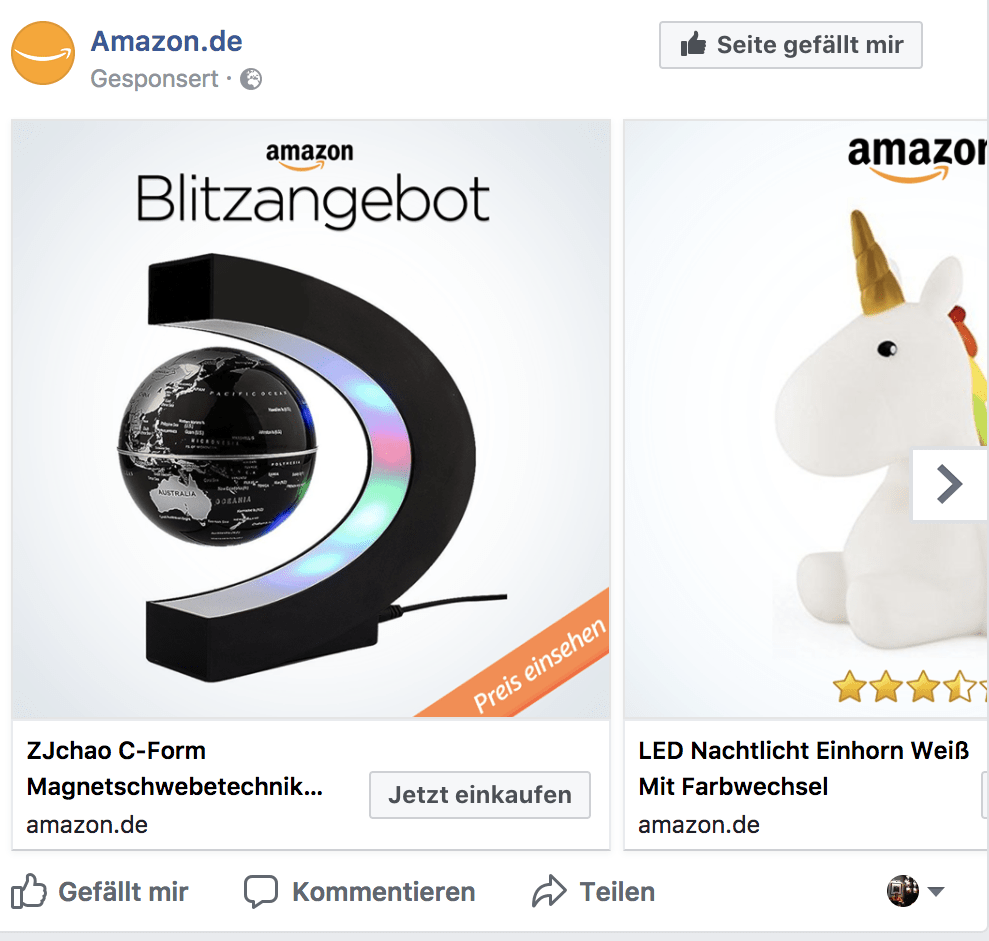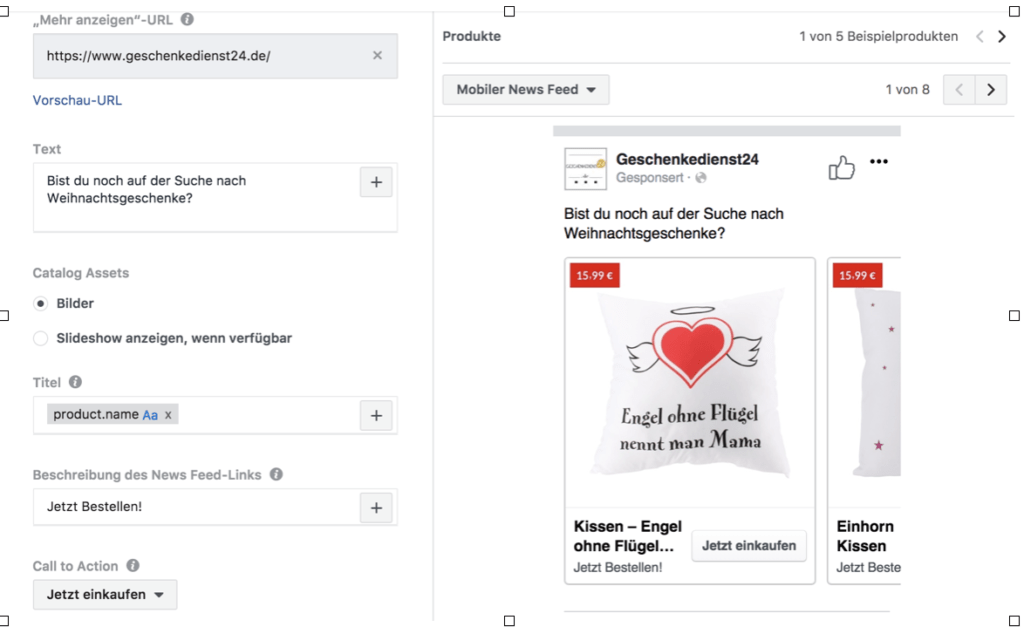The switching of Facebook campaigns is one of the most promising measures in performance marketing. Fantastic CPO (cost-per-order) and ROAS (return on advertising spend) values can be achieved, especially when running retargeting campaigns. In my client projects, I always try to run Facebook retargeting campaigns as quickly as possible, as profitable results can be achieved with comparatively little effort. So that you too can enjoy the benefits of high-performance Facebook campaigns here are my instructions on how to switch the Facebook retargeting campaigns before.
What are Facebook retargeting campaigns?
Retargeting campaigns ultimately involve retargeting users who have already been in contact with your company. In principle Retargeting campaigns not only be placed via the Facebook advertising network - some time ago, I already introduced the placement of Retargeting campaigns in the Google network. The basic idea of retargeting is to achieve an increased conversion rate by addressing users again. This idea originates from eCommerce, where only in the rarest of cases does a user make a direct purchase on their first visit to an online store. For this reason, retargeting users is all the more important. The use of retargeting campaigns has also been further increased by the sharp rise in the use of mobile devices. As the Conversion probability is lower on average on mobile devices than on desktop computers, retargeting campaigns are essential.
Different retargeting target groups in the Facebook advertising cosmos
As already mentioned, retargeting campaigns involve addressing users again. In order to ensure retargeting, the target group to be addressed must first be defined. Fortunately, Facebook offers us a large selection of possible target group definitions, which I will discuss in detail below.
Custom audiences as a basic requirement for retargeting campaigns
User-defined initial target groups for Facebook retargeting campaigns are referred to as custom audiences. Before a retargeting campaign can be started, a custom audience must first be defined and created.
Different types of custom audiences:
- Website Custom Audience
- Custom audience based on customer lists
- App Custom Audience
- Offline Custom Audience
- Engagement Custom Audience
Website Custom Audience:
The website custom audience is the best-known and most frequently used custom audience. Visitors to your website are used as a custom audience, whereby a very fine target group definition is possible. For example, only users who have visited certain subpages can be addressed, or people who have spent a certain minimum amount of time on your website. This ensures that only the most relevant people are addressed again. This type of target group definition is highly recommended for online stores in particular, as users who have looked at certain products and added them to their shopping cart without completing the order process can be targeted. This type of Facebook retargeting campaign is known as Dynamic Product Ads. You can find out how to run these campaigns in the "Dynamic product ads" section. However, in order to be able to target your website visitors in general, the implementation of the Facebook pixel is essential. You can find out how to implement your Facebook pixel and how to create the website Custom Audience based on user interactions here.
Custom Audience based on customer lists:
For the circuit of retargeting campaigns based on customer lists, you basically do not need a Facebook pixel. Nevertheless, I recommend that you implement the Facebook pixel in order to ultimately be able to better evaluate your Facebook campaigns. To generate a custom audience based on customer lists, you only need some information (email, name, etc.) of the respective target group, which you can then upload to Facebook as a CSV or TXT file. As a general rule, the more information you provide to Facebook, the more users Facebook will ultimately recognize. Because only if Facebook can assign the contact data to a user will there ultimately be a successful match. The creation of custom audiences based on customer lists is controversial for data protection reasons and should be checked by a lawyer beforehand.
App Custom Audience:
With the Custom Audience app, you can create a list of users who have interacted with your app or performed certain actions. Custom audiences can be created based on events such as app installations, registrations in apps or purchase events. In particular, retargeting campaigns to people who have installed your app but not yet registered are an effective method of increasing the engagement rate in your mobile app.
Offline Custom Audience:
Offline custom audiences are a list of people who have not come into contact with your company via the internet. Offline custom audiences are particularly interesting for companies where the final conversion is not mapped digitally. Stationary retailers can advertise their store and create a custom audience based on the customer data collected (emails, names, etc.).
Engagement Custom Audience:
Engagement Custom Audiences allows you to create a list of users who have interacted with your content on Facebook or Instagram. For example, you can create a custom audience of people who have watched your video or liked a post on your Facebook fan page. People who have RSVP'd for one of your events can also be added to your specific target group using Custom Audiences. There are numerous selection and combination options for Engagement Custom Audiences, which I will not go into here.
Which Custom Audience should I create for my Facebook retargeting campaign?
When running Facebook retargeting campaigns, it is generally recommended to target those users who are in the lower part of the funnel but have not yet made the desired conversion. In the case of an online store, it is therefore advisable to target visitors who have looked at products or added them to their shopping cart but have not yet completed the purchase. The same applies to the promotion of events via Facebook. It is therefore advisable to contact people again who have already visited the event page but have not confirmed their attendance at the event.
Dynamic retargeting ads - instructions
In the following, I will show you how you can place Dynamic Product Retargeting Ads for your online store and how I have used them in the last few days from 67,89 € a turnover of 3.311,90 € have generated. Below you can see a screenshot with the conversion values mentioned.

What are dynamic retargeting ads?
Dynamic retargeting ads involve the display of products in the Facebook advertising networkwhich certain users viewed a certain time ago but did not purchase. The design of the ads can be defined as usual on Facebook. When placing dynamic retargeting ads, I personally like to work with Carrousel ads, as you can see below.

Requirements for the placement of dynamic retargeting ads
Before dynamic retargeting ads can be placed, a number of requirements must be met:
- Product catalog feed must be transferred to Facebook.
- The Facebook pixel must be implemented & the most important events (add-to-cart, purchase) must be created.
Facebook product catalog feed
The product catalog feed contains all products that are available in your online store, as well as the necessary information. You can use the Product catalog feed to Facebook both manually and dynamically. With manual transfer, you upload the Facebook feed to Facebook as a CSV file. This has the disadvantage that the product feed has to be uploaded again manually every time a product changes (price, availability). For this reason, I advise you to transfer the product catalog feed to Facebook dynamically so that Facebook has the latest information and can process it. With the dynamic Product catalog reproduction your online store or merchandise management system transfers a URL that Facebook can access so that it receives the latest product information.
What information must the product catalog feed contain?
- Product ID
- Availability
- Condition
- Description
- Image URL
- Title
- Brand/GTIN
- Price
- Link
This information is a mandatory field for each product that is to be displayed in the product catalog feed. In addition to these 9 mandatory fields, there are other fields (e.g. product category, gender, etc.) that can also be filled in.
Facebook Pixel & Events
In order for Facebook to know which visitors have viewed products in your online store, the various events must be passed on in addition to the Facebook pixel. This is done by integrating the Facebook pixel and the conversion events. The events Add-to-Wishlist, Add-to-Cart, Initial-Checkout, AddPaymentInfo & Purchase, which are relevant for eCommerce, should undoubtedly be integrated. Available parameters such as "Item-Price" should also be transferred so that you can also measure the ROAS in the Facebook Ads Manager.
There are plugins for numerous store and CMS systems that significantly reduce the effort of pixel & event integrations. Here are some links to the most popular plugins:
- WooCommerce (Facebook pixel & event integration: http://www.pixelyoursite.com/facebook-pixel-plugin)
- WooCommerce Product Feed (http://www.pixelyoursite.com/product-catalog-facebook)
- Shopify Pixel integration (https://apps.shopify.com/pixel-perfect)
- Shopify product feed (https://apps.shopify.com/facebook-product-catalog)
- Mageto Facebook Pixel & Event Integration (https://marketplace.magento.com/cadence-cadence-fbpixel.html)
- Magento Facebook Product Feed (https://www.xtento.com/product-feeds/magento-facebook-dynamic-product-ads-integration.html)
Tip: By correctly integrating the product catalog, you can not only place dynamic retargeting ads, but also use the product catalog information to place Lookalike campaigns to play out your products. A great combination has been known for several months under the name "Dynamic Product Ads with Broad Audience".
Creation of Dynamic Product Ads
So that we can play Dynamic Product Ads to our preferred Custom Audience, we must select the ad target "Product catalog sales" in the Ads Manager.
The first step towards Ad group level is the selection of the product range. Here you select the product catalog that contains the products to be advertised. After selecting the product range, the number of products is also displayed directly.
Once we have communicated the advertising objective, the name of the campaign and the product range to be advertised to Facebook, we can now go to Ad group level the relevant targeting options of the Custom Audience select. These include, among others:
- Viewed or added to shopping cart but not purchased
- Added to the shopping cart but not purchased
- Up-selling products
- Cross-selling products
- User-defined combinations
As you can see, we can not only Dynamic retargeting campaigns but also Up-selling- and Cross-selling campaignsto increase the average shopping cart value. In my example, I will select the targeting option "Viewed or added to cart but not purchased". Here you also have the option of specifying a time window in which the action was carried out. Basically, the following can be said: the shorter the period between the product view and the display of the Advertisement on Facebook the higher the probability of a conversion. For products that require more explanation and have a longer decision horizon (e.g. cars, heating, etc.), the use of longer time periods is recommended.
In the next step - as already known - the Placement of advertisements (Automatic placement vs. Edit placement). Here I usually select "Edit placement" to assign a separate ad group to each placement and adapt the title and description to the respective ad format at ad level.
I then select the function "Specific mobile devices", select the option "Only with an existing Wi-Fi connection". In this way, I want to prevent people from being addressed who are sitting in the subway, for example, and whose conversion probability is limited due to an insufficient Internet connection.
As usual, the last step at ad group level is the configuration of the Budgets & Schedules on. Here you can choose between a term budget and a daily budget. Particular attention should be paid to the selection functions "Ad placement optimized for" and "Type of event" are placed. As we want to generate sales with our Dynamic Product Ads, we recommend placing ads that are optimized for conversion. For the type of event, the selection depends on the frequency of conversion. Facebook requires 50 conversions at ad group level to get an accurate picture of the optimal target group. If the 50 conversions cannot be generated at the beginning via the "purchase" event, an event in the upper part of the conversion funnel (add-to-cart, product view, etc.) should be optimized.
Dynamic retargeting ad design
Once we have completed the settings at ad group level, we now determine the graphic design of the ads. First, we name the ad and tell Facebook both our Facebook fan page and our Instagram page. Then we have to decide whether we want to display ads in the Carousel format or as single picture want to switch.
As these are dynamic ads, products are displayed dynamically according to interaction so that only those products are shown that the person in question has actually looked at.

The design of the ads works in exactly the same way as with conventional ad design. One major difference, however, is the dynamic description of title, text and news feed link, which is displayed with the content of the product feed. In addition to the product image, the product name and product price can also be displayed. This is done completely automatically.
The option has also recently become available, Overlays in the product images. As Overlays the price, the crossed-out price and the discount in percent are currently available. By using the overlays, further information can be passed on to users without taking up additional space in the title or text.
In the last paragraph of the ad design, a UTM parameters to enable the conversion to be tracked easily in Google Analytics.
I hope you enjoyed my article on Facebook retargeting. If you have any questions, I would be delighted to hear from you.


